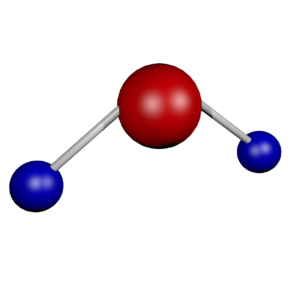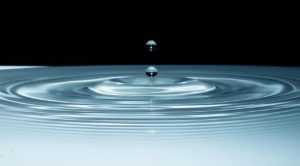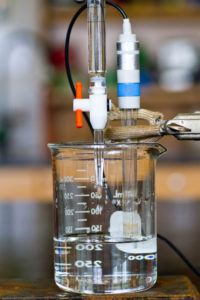Hydroxonium is an ionic product of water. Its lifetime is about one ps, which is about the same as that of a hydrogen bond. This gives it the ability to associate a charge with 107 water molecules before neutralization. This article will help you determine which hydroxonium ion is present in water. The following equation outlines its structure.
Ionic product of water equation
 The concentration of hydroxide ions in water is proportional to pKw, the ionic product of water. The concentration of hydrogen ions decreases with an increase in temperature, so as the water gets colder, it becomes acidic. This reaction involves the breakage of bonds and requires energy. The energy favors the forward reaction, so as the temperature increases, the position of equilibrium shifts to the right.The ionic product of water is called pKw and is equal to the concentration of hydroxonium ions in pure water.
The concentration of hydroxide ions in water is proportional to pKw, the ionic product of water. The concentration of hydrogen ions decreases with an increase in temperature, so as the water gets colder, it becomes acidic. This reaction involves the breakage of bonds and requires energy. The energy favors the forward reaction, so as the temperature increases, the position of equilibrium shifts to the right.The ionic product of water is called pKw and is equal to the concentration of hydroxonium ions in pure water.
However, to avoid adding another constant, the ionic product of water can be replaced by H+ in the Kw expression. In equilibrium, the concentration of each ion depends on its temperature, and Lechatelier’s Principle states that the reaction must decrease H+ and use OH to react with newly added H+.Quantum cluster equilibrium theory provides a more accurate method for calculating the ionic product of water than the density functional theory. By combining density functional theory and ab initio methods, it is possible to obtain pKw from finite cluster structures and thus make the calculation of ion product of water more accurate.
This method can be applied to calculate the ionic product of water and its T-dependence.The ionic product of water (pKw) varies with temperature. Water molecules can act as acids and bases by accepting hydrogen ions from other water molecules. Pure water contains hydrogen ions, which can be accepted by any water molecule. The hydroxonium ions, for example, are very strong acids. These ions react with H3O+ molecules to produce water.
mRRHO

mRRHO is an ionic form of hydride. Hence, mRRHO is the negative logarithm of OH. Its vapor pressure is 1.3 MPa at 298°C, and its enthalpy is 1.1 kJ mol-1 at 373°C. Its molecular weight is 86.9 g/mol.
mRRHO is derived from the ionic form of water. It is a mixture of ion pairs with different energies. These ionic forms are grouped by structural motifs. They do not exhibit vibrational modes below 100 cm-1. Therefore, the modified vibrational partition function of mRRHO50 does not affect the population of the monomer or dimer.
The structure of mRRHO can be characterized by its temperature dependence. The ion pairs are net neutral clusters with zwitterionic character. The clusters are characterized by Eigen-ion motif (a single H+ shared between two water molecules), and Zundel ion motif (one H+ shared between two water molecules). The separated ion pairs are pentamer to decamer in size. Each ionic pair has three hydrogen bonds.
The concentration of mRRHO is determined by the temperature of the solution. Water is a weak electrolyte and undergoes self-ionisation to a small degree. However, it has no strong protons or electrons in the liquid form. Because of this, mRRHO is an ionic product of water that increases with temperature. This property helps us understand how the chemical reaction takes place in water.
Hydroxonium has the same properties as hydrogen ions. It has a lifetime of one ps, which is nearly as long as the hydrogen bond. It can associate with over 107 water molecules before neutralization. The existence of mRRHO is an indicator of a low-level of acidity in a solution. It also helps understand why acidic and base chemicals react so badly with one another.
XXX basis set

An example of an ICP is ThOH+, a stable ionic compound. Its ground state is ThOH+ (1A’), and its energy is 1.1 eV higher than that of the ionic product 1A. However, a potential energy surface (PES) for the ionic product is not available. Fortunately, several studies have attempted to calculate the PES of this compound.
The QCE method predicts the ionic product of water with absolute values of ion concentration and (p, T)-dependent data, independent of reference points and ad hoc models. The results of QCE are thermodynamic and compliant with the laws of thermodynamics, and they are related to the properties of the underlying clusters, including their reactive, structural, and spectroscopic properties.
The ANO basis sets are most appropriate for describing the electronic structure of diatomic molecules. Their use is particularly prevalent for basis set development and highly accurate simulations of small molecules. They are also commonly used for intramolecular BSSE. ANO and NEO basis sets are both effective tools in studying the structure of complex systems. In addition to being extremely accurate, they are based on the atomic structure of small molecules.
A significant issue in electronic structure calculations is the so-called basis set superposition error (BSSE). In these models, the energy contribution of the monomers to the dimers is artificially shifted down due to the stabilizing effect of the overlapping basis. However, this problem can be overcome using alternative basis sets. Despite the BSSE, the PST-based calculations are accurate within 9% of the experimental branching ratio.
The polycyclic motifs used in this model are relatively robust to ion-pair separation and link together by Grotthus-compliant “buttresses.” These structures also have the ability to reproduce the catalytic effects of the surrounding environment.
Ionic product of water at 25 degree Celsius

Hydroxonium ion is an example of an ionic product of water. In equilibrium, the concentration of hydronium ion is 2.0 x 10-6 M, and that of hydroxide ion is 5.0 x 10-9 M. The KW value of this reaction is a constant value at 25 degrees Celsius, and it is the same as that of pure water at that temperature. Therefore, solutions are classified by their concentrations of OH and H3O+.
The IUPAC nomenclature for organic chemistry requires that an ionic product of water be called hydroxonium. However, if the substance contains only one type of hydroxonium, it should be called hydroxonium. The latter term should be used whenever possible. Hydroxonium is an ionic product of water that has two states: oxidation and reduction.
The HO and OH ion concentrations of pure water depend on the concentration of base and acid. If the concentration of hydronium ion is above one x 10-7 M, the solution is said to be basic. However, if the concentration of hydroxide ion is below one x 10-7 M, it is termed alkaline.
The OH and H+ ions are the two main ions in water. Their concentrations are equal at room temperature and at other temperatures, they have different numerical values. The equilibrium expression for autoionization of water can be used to relate the concentrations of acid and base. If a generic acid is added to water, it will dissociate into A and hydronium ions, resulting in the formation of an ionic product of water called the Hydroxonium ion.



[…] acid or base that is sufficiently strong will completely dissociate to form hydrogen ions and a conjugate base. A weak acid, on the other hand, is less willing to donate a proton. In this […]